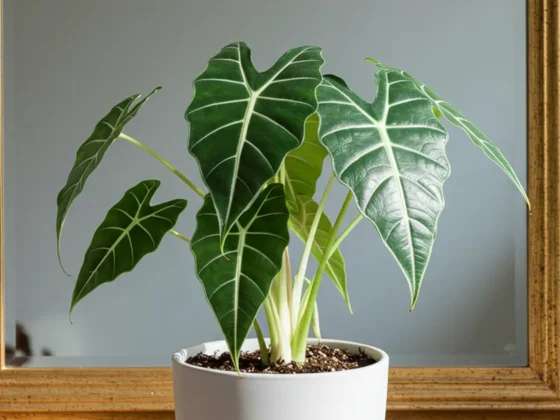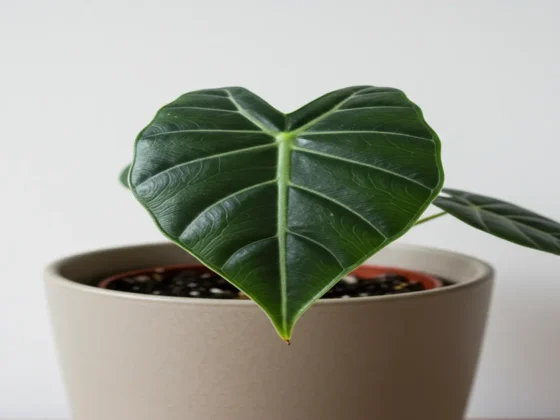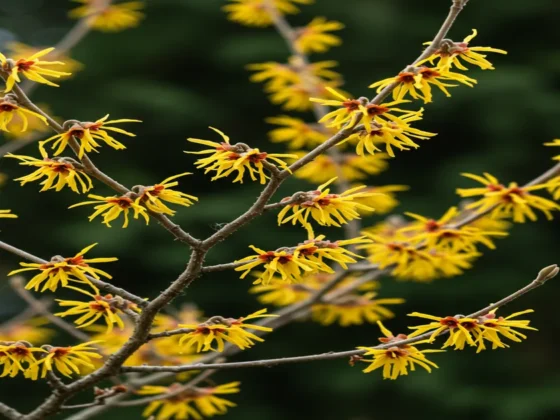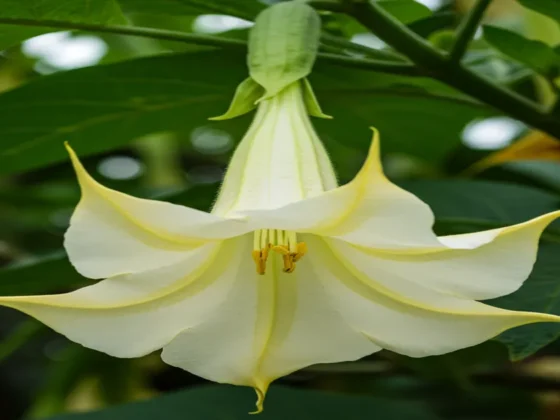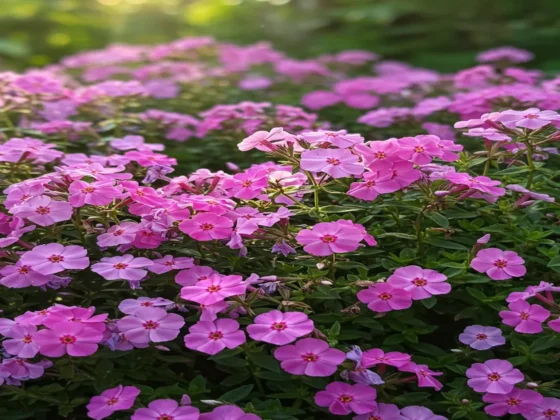Ready to elevate your houseplant collection? Consider the Dragon Scale Alocasia (Alocasia baginda ‘Dragon Scale’). This exquisite plant is admired for its distinctively textured leaves, reminiscent of dragon scales. Its compact size makes it ideal for smaller spaces, making it a sought-after choice among plant enthusiasts and collectors, albeit often challenging to acquire due to its popularity and price tag.
Hailing from the rainforests of Borneo, this tropical perennial has specific requirements for successful indoor growth. Not known for being low-maintenance, if you lack a green thumb, you might want to start with an easier and more affordable alocasia such as the Amazonica or Polly.
| Common Name | Dragon Scale Alocasia |
| Botanical Name | Alocasia baginda ‘Dragon Scale’ |
| Family | Araceae |
| Plant Type | Perennial, corm |
| Mature Size | 2-3 ft. tall, 1-2 ft. wide (indoors) |
| Sun Exposure | Partial |
| Soil Type | Moist but well-drained |
| Soil pH | Neutral, alkaline |
| Bloom Time | Spring, summer |
| Flower Color | Green, white |
| Hardiness Zones | 9-11 (USDA) |
| Native Area | Asia |
| Toxicity | Toxic to humans and pets |
Caring for Alocasia Dragon Scale Plants

If you have successfully cared for an alocasia before, you should find it relatively easy to care for the dragon scale alocasia. Although less finicky than some of its relatives, it still requires more attention compared to other houseplants. The key to growing these tropical plants indoors is to provide them with sufficient light and humidity, replicating the rainforest conditions where they naturally thrive.
The main attraction of the dragon scale alocasia is its striking foliage, but it also produces small spathe-like flowers during the spring and summer.
Lighting
Dragon scale alocasias prefer bright indirect light, similar to the dappled light in the rainforest understory. Avoid direct sunlight to prevent leaf burn and rotate the plant regularly to promote even growth on all sides.
Soil
Dragon scale alocasias require a well-draining potting mix with a chunky texture. An ideal mix consists of equal parts coco coir, perlite, and orchid bark. Alternatively, you can use sandy potting soil instead of coco coir. Avoid using dense potting soil to prevent root rot.
Watering
Regular watering is essential for dragon scale alocasias, and the soil should not be allowed to completely dry out. However, they can tolerate occasional missed waterings better than some other alocasia varieties. Water thoroughly once the top 1 to 2 inches of soil have dried out.
When using a soilless potting mix, it’s best to bottom-water the plant by placing it in a container of water for 10 to 15 minutes. Allow excess water to drain before returning the plant to its original spot.
Temperature and Humidity
Dragon scale alocasias, like most alocasias, thrive in high humidity levels of 60% to 80%. They do well in terrariums, mini-greenhouses, or near a small humidifier. These plants prefer indoor
Varieties of Alocasia Dragon Scale

Alocasia ‘Silver Dragon’ is often mistaken for Alocasia ‘Dragon Scale,’ however, these are distinct cultivars of Alocasia baginda. The primary distinguishing factor between them is their coloration—the silver dragon features lighter foliage with a silvery shimmer, whereas the dragon scale has significantly darker leaves.
Trimming

Keeping the foliage of dragon scale alocasia requires minimal effort. Just trim and discard any dead leaves and plant debris that could attract diseases and pests.
Propagation of Alocasia Dragon Scale
Alocasia dragon scale can be propagated through division and by growing corms. To propagate this plant, it is advisable to wait until it reaches at least one or two years of age. While propagating alocasias may not be as straightforward as with some other houseplants like pothos, it can be successfully achieved by following a few simple steps.
To propagate through division, a mature plant with new smaller plants or pups needs to be obtained.
- Prepare several small potting containers filled with a well-draining potting mix and set them aside.
- Take out the alocasia and its pups from the pot and lay them on the ground.
- Gently loosen the soil around the base of the pups to expose the roots using your hands, taking care not to damage them.
- Separate the pups and their root systems from the mother plant and pot them in the prepared containers, firmly pressing the soil around the new plants.
- Thoroughly water the newly separated plants, allowing excess water to drain, and return the mother plant to its original pot, adding soil as necessary.
- Position the new plants in a spot with bright but indirect light and maintain even soil moisture.
To propagate Alocasia Dragon Scale by growing corms, follow these steps.
- Remove the dragon scale Alocasia from its container and lay it on the ground.
- Carefully dig around the plant’s roots with your hands until you locate small corms in the soil, ensuring minimal root damage. The corms should be solid and may or may not have their own root systems.
- Take out the corms from the mother plant’s soil and remove the outer brown layer.
- Put the corm in a container with moist sphagnum moss, making sure the top is not covered. Then, cover the container with a plastic bag, sealing the top to create a greenhouse effect.
- Position the pots and bags in a warm, brightly lit area, opening the bags weekly for airflow. Growth signs should appear within a few weeks, either in the roots or on top of the corm. Keep the sphagnum
How to Pot and Repot Alocasia Dragon Scale
Alocasia dragon scale can tolerate being slightly root bound and should be repotted every two to three years or when roots start to grow out of the pot’s bottom. It is ideal to repot these plants from mid-spring to early summer when they are actively growing and not dormant.
Select a pot that is 1 to 2 inches larger than the previous one, and replace as much of the potting mix as possible without harming the plant’s roots. Once you have repotted your dragon scale, water it generously to aid its adjustment to the new container.
Types of Pests and Diseases Found in Plants
Various common pests such as fungus gnats, scale insects, spider mites, and thrips can pose problems for a dragon scale alocasia plant. Make sure to frequently check your plant for any indications of pests and promptly use an insecticide if an infestation is detected. Additionally, the plant is prone to root rot, typically caused by incorrect watering techniques and/or poor drainage.
Issues commonly observed with Alocasia Dragon Scale
Alocasia Dragon Scale plants can flourish indoors under optimal conditions, but if their requirements are not met, you may encounter some common problems.
Leaf Drop
If your Alocasia Dragon Scale is shedding its leaves, it is likely due to inadequate light, water, or humidity. Evaluate the plant’s environment to identify any deficiencies.
Alocasias can naturally enter a dormancy phase during autumn and winter, shedding all leaves. This may not always occur indoors, but it is a possibility. If your plant goes dormant, do not worry. Reduce watering and wait. New growth should emerge in early spring.
Yellowing Leaves
Yellow leaves on an Alocasia Dragon Scale often indicate overwatering or potential root rot. Cut back on watering to prevent further yellowing and inspect the roots for signs of rot.
Curling Leaves
Curling leaves on your Alocasia Dragon Scale typically suggest insufficient moisture and humidity. Ensure you are not underwatering and try to increase humidity around the plant.
FAQ
Is Alocasia ‘Dragon Scale’ rare?
Alocasia ‘Dragon Scale’ can be challenging to find and is generally considered uncommon. While nurseries and garden centers occasionally sell the plant, it can also bepurchased onlineor from plant enthusiasts.
Does Alocasia ‘Dragon Scale’ like misting?
Although Alocasia ‘Dragon Scale’ thrives in moist, humid conditions, misting is not the most effective



